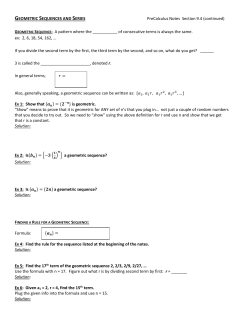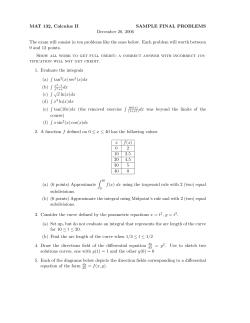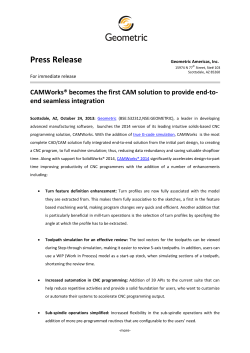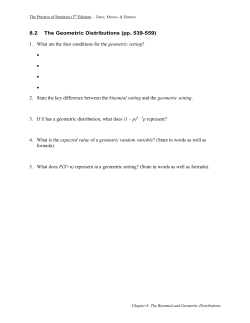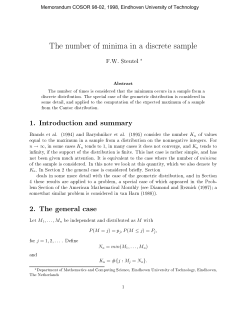
Geometric Mean - What Does it Mean? Robin S. Kalder, Ed.D.
Geometric Mean 1 Geometric Mean - What Does it Mean? Robin S. Kalder, Ed.D. Associate Professor/Assistant Chairperson Department of Mathematical Sciences Central Connecticut State University New Britain, CT 06811, USA 860-832-2842 kalderr@ccsu.edu Geometric Mean 2 ABSTRACT The National Council of Teachers of Mathematics and numerous mathematics educators promote the combination of conceptual understanding and procedural learning in the successful instruction of mathematics. Despite this, when geometric mean is taught in a typical American geometry class, it is taught as a process only despite the many connections that could be made. This paper discusses a number of the connections that can be made when geometric mean is taught in the mathematics classroom. Keywords: geometric mean, geometric ratios, golden mean, golden ratio, conceptual learning, connecting mathematical concepts Geometric Mean 3 Introduction I once saw a t-shirt that on the front read: “He said I was average” and on the back read, “I thought he was mean.” Of course, this caused me to smile, but then I began to think about the different uses of the word “mean” not only in our daily lives, but, more pointedly, in mathematics. Although most mathematical ideas are universal, mathematical language and notation is not. Therefore the importance of clearly and completely explaining terms for understanding is evident. At least since the 1930’s, school mathematics instruction has emphasized learning without understanding, sparking a great deal of discussion and debate among mathematics educators (NCTM, 2000; Loveless, 2001). The Learning Principle, which was proposed by the National Council of Teachers of Mathematics (NCTM) to assist in changing this precedent, requires conceptual understanding to be part of all mathematics instruction. Subsequent studies have investigated the interaction between instruction of procedures and instruction for conceptual knowledge, and the affects these have on student achievement. In a 2000 study conducted by Pesek and Kirshner, two groups of students were taught a unit on area and perimeter, with one group’s (R-O) instruction focusing on conceptual understanding and the other group’s (I-R) instruction beginning with procedural knowledge, then followed by relational instruction. The students in the I-R group were taught formulas first, and then taught the concepts. The instruction for the students in the R-O group focused on relationships and concepts, and students constructed their own procedures. Ultimately, the I-R group needed twice the instructional time that was needed by the R-O group, and even Geometric Mean 4 then, when questioned after instruction, the I-R students were unable to make connections between area, perimeter, and real-world situations (Pesek and Kirshner, 2000). When students were asked questions about area and perimeter, the I-R students’ answers were based on calculations and procedures, often incorrect, and they were not able to explain why the formulas worked. The R-O students on the other hand, were able to make sense of the formulas, and whatever statements they supplied were correct, although not always complete. This occurred despite the fact that the R-O students had not been given the formulas explicitly (ibid). A study that was conducted by Rittle-Johnson, Siegler and Alibali in 2001 concluded that concepts-first instruction is not necessarily needed. When examining the understanding of decimal fractions by elementary students, their findings indicated that significant improvement in achievement is a consequence of the intertwining of procedural and conceptual instruction. So although they concluded that there is no definitive answer as to which should come first, they did assert that both conceptual and procedural knowledge is important. Numerous additional studies also indicate the importance of focusing on conceptual understanding in mathematics instruction in order to promote thorough mathematical skill development (McNeil and Alibali, 2005; Hiebert et al., 1997; Stein, Grover, and Hemmingsen, 1996; Eisenhart et al., 1993). A way in which to accomplish students’ conceptual understanding of new mathematical material is for teachers to make the information conceptually relevant to the students. Although more of this is happening in today’s classrooms, there are Geometric Mean 5 some topics for which this still is not being done. One such topic for which there is little to no movement in the direction of teaching in context is the concept of the geometric mean. As found in the American textbooks reviewed for this article, geometric mean is still presented to students as a procedure with no connection to other mathematics or real-world contexts. A richness of connections to other mathematical topics exists, as do real-world connections to the topic of geometric mean. Some of them will be presented in this article. The Uses of the Word “Mean” in Mathematics The two most common uses of the word “mean” in secondary mathematics are in the expressions arithmetic mean and geometric mean. The concept of arithmetic mean, or average, is taught for the first time in the elementary grades, and is reinforced in most middle school curriculums. At both of these levels there is a great deal of attention paid to having students understand the concept of finding an average, not simply calculating it. An example of how this is accomplished can be found in the Math Trailblazers 5th grade textbook. Students are given a basketball player’s point scores in five separate games. They are then told to build towers of connecting cubes with lengths equal to the scores of 4, 6, 4, 23 and 28. Once they observe these towers, they are then asked to make the same number of towers (five), with the same total number of cubes (75), but now to have each tower of the same height, and therefore the same number of cubes. Students discover that this can be accomplished by having five towers with 13 connecting cubes each. The text then concludes that the 13 Geometric Mean 6 cubes in each tower represent a mean score for this basketball player in each game. The formula for finding an arithmetic mean is not given to students until after they perform this same kind of exploration a number of times, thus building conceptual understanding prior to being given a procedure (TIMS Project, 2003). Geometric mean, however, is typically not presented in this combination of concept and calculation. Despite the fact that research indicates that teaching for meaning in mathematics has positive effects on student learning that is long lasting (McNeil and Alibali, 2005; Rittle-Johnson, et al., 2001; Grouws, et al., 2000; NCTM, 2000), this is one of the concepts that is still presented solely as a procedure. The definition and explanation of the term geometric mean has remained essentially the same for the last thirty years, despite recent movement towards teaching mathematics conceptually. Present and Past Presentations of Geometric Mean Looking back to a geometry text published in 1981, the definition of geometric mean is introduced with proportions given in which “…the means are the same. When this is true, a mean is called the geometric mean of the two numbers” (Keedy, et al., 1981, p. 292). The definition itself is given: “For any positive numbers, p, q, and r, q is the geometric mean of p and r if and only if p q = “ (ibid). Similarly, q r a text published in 1991, gives the definition as “If the means in a proportion are equal, either mean is called a geometric mean, or mean proportional between the extremes” (Rhoad, et al., 1991, p. 327). This definition differs only from the previous Geometric Mean 7 one in that it allows the geometric mean to be both positive and negative. But these texts were published before the NCTM Principles and Standards, were published in 2000, so more recent texts were reviewed. Unfortunately the definition and explanation of geometric mean found in more recent textbooks is the same. A 2001 textbook has the definition, “When the middle terms, or means of a proportion are equal, that value is the geometric mean of the extremes. If a x = , then x is the geometric mean of a and b and is equal to the x b positive square root of ab” (Manfre et al., 2001). The final textbook examined for the purposes of this study, which was also the most recently published of the textbooks, supplies the definition: “For any two positive numbers a and b, the geometric mean of a and b is the positive number such that a x = . Note that x = ab ” (Bass, 2007, p. x b 392). When applications follow these definition, the two most common ones are that the altitude to the hypotenuse of a right triangle is the geometric mean between the segments into which the hypotenuse is divided, (figure 1, formula 1) and that each leg is the geometric mean between the hypotenuse and the segment on the hypotenuse that is adjacent to the leg (figure 1, formula 2). Students then apply the formula, and find the lengths that are required, but the question remains as to whether the students have any notion of the underlying concept of geometric mean, or its connection to other mathematics. Geometric Mean 8 a b h d e c Formula 1: h = d * e Formula 2: a = c * d and b = c * e Figure1: The altitude drawn to the hypotenuse in a right triangle. Simply presenting this concept procedurally in this way has been dissatisfying to me, and confusing to my students. In feeling it advantageous to develop and present the concept of geometric mean to my students with a significant conceptual component and a connection to real-world examples, I developed the following approaches. Presenting Geometric Mean with Meaning I begin with a brief introduction to sequences. Students are presented with different arithmetic sequences until they are able to supply the next term for each, and recognize the pattern that sequential pairs of terms have a common difference. We then discuss the concept of arithmetic mean as being the middle term of three consecutive terms in an arithmetic sequence. This definition for arithmetic mean is Geometric Mean 9 not given as a formula, but instead, as a concept. What naturally develops subsequently is the search for a formula. The question for students is whether or not the formula we find will be consistent with the formula they have known and used for years; to find the average of two numbers, add them and then divide the sum by two. We then use the concept just presented to find the missing middle term, or arithmetic mean, if the first and third terms of an arithmetic sequence are given. To begin I use an example. If we are given that 5, n, 13, are three consecutive terms in an arithmetic sequence, how do we find the value of n? If we call the common difference “d” then the following statements can be made: 5+d =n 13 - d = n . Adding these two equations together we obtain 5 + d + 13 - d = n + n , which simplifies to 5 + 13 =n 5 + 13 = 2n and finally to . Generalizing this consequence for three 2 consecutive numbers in an arithmetic sequence, a, b, c, we arrive at the formula for a+c =b the Arithmetic Mean 2 . Students have been using this formula for years, but now there is additional background as to how the formula evolved. This sets the stage for a similar investigation of geometric mean. Students are subsequently presented with different geometric sequences until they are able to supply the next term for each, and recognize the pattern that sequential pairs of terms have a common ratio. We then discuss the concept of geometric mean as being the middle term of three consecutive terms in a geometric Geometric Mean 10 sequence. This definition for geometric mean is also not given as a formula, but instead, as a concept that is consistent with the concept of arithmetic mean that was previously developed. Now a formula for finding the geometric mean can be developed. Once again, I begin with an example of three consecutive terms in a geometric sequence such as 4, n, 36. In this case, the middle term would be the geometric mean. We can call the common ratio of the geometric sequence “r” and write the following two statements: equal to each other we have n 36 = r , and = r . Setting these two equations 4 n n 36 2 = . Eliminating the fractions yields n = 4 * 36. If 4 n we solve for n, we have n = ± 4 * 36 . We then have a discussion as to how in a geometric sequence “r” can be either positive or negative, but there may be applications where it is one or the other. Generalizing this consequence for three numbers in a geometric sequence, a, b, c, we arrive at the formula for the geometric mean b = ± a * c . When it is time to discuss the geometric mean with respect to the lengths of segments in the right triangle we no longer have to consider the negative values of “b”, so the formula becomes b = a * c . Students can now look at this formula as having been easily derived from a geometric sequence instead of simply being a formula that the teacher has given them and that they had to memorize. The Golden Mean Geometric Mean 11 One of the most interesting applications of geometric mean is the Golden Mean also known as the Golden Section or Golden Ratio. Many students know that the value of the Golden Mean is approximately 1.618, but none of them seem to know why. Again, when this topic is mentioned in a typical high school text, the number is simply given to the students, with no description of its origin and no derivation sought or supplied. The description that I use, and which appears to be most meaningful to my students, uses similar rectangles. Given a rectangle with width = a and length = b, find the distance along the length that is equal to the width, and use it to create a square within the rectangle (figure 2). b a a b-a a a a Figure 2: Rectangle with dimensions “a” and “b” Now the original rectangle is comprised of a square and a smaller rectangle. If the smaller rectangle is similar to the larger rectangle, then both contain the Golden Ratio. In other words, the ratio of either rectangle’s length to its width is this special number, and a rectangle with this property is not ordinary. Since similar Geometric Mean 12 polygons have corresponding sides that are in proportion, the following statement can be written: b a = a b-a At this point it should be noted that this statement asserts that “a” is the geometric mean between b and b-a, and that b-a, a, b, would be three consecutive terms in a geometric sequence. This observation explains the “mean” part of the name “Golden Mean.” We then proceed to further investigate the “Golden” part of the name. We now look to find exactly what this property will yield. As we are discussing ratios, we know that the ratio b:a can have many forms. Without loss of generality, we select the form where a=1. This yields the proportion b 1 and = 1 b -1 we are now able to solve for “b”: b ( b - 1) = 1 b2 - b - 1 = 0 Using the Quadratic Formula to solve for “b,” we arrive at the value of b to equal 1+ 5 , once again eliminating the negative value, which is also a solution to the 2 equation, but cannot be used to represent the length of the rectangle. Therefore the Golden Mean, which is b b in simplest form and in the most general form equals 1 a approximately 1. 618. It is easy to find examples of where this ratio is found in nature (pine cones, sunflowers), architecture (the Parthenon, the Great Pyramid), and art (Venus de Milo statue, Mona Lisa by Leonardo Da Vinci, Self-Portrait by Rembrandt). Geometric Mean 13 Depending upon time and curriculum demands, these can be explored through interdisciplinary activities. According to the NCTM's Principles and Standard for School Mathematics (2000), connections to other disciplines, (e.g. science, social studies, art) as well as to the real world greatly improves the experience of students in mathematics. Connecting to an Interesting Property One of the most unexpected properties of the Golden Mean is the fact that if 1 is subtracted from it, the result is the reciprocal of the Golden Mean. In symbolic notation this is represented as 1+ 5 2 -1= . We can verify this statement in 2 1+ 5 the following way: 1+ 5 1+ 5 - 2 -1= 2 2 1+ 5 - 2 5 -1 = 2 2 5 -1 5 +1 5 -1 i = 2 5 +1 2 5 +1 rationalizing the numerator: ( 2 and simplifying to: ( 5 -1 = ) 2( 5 +1 4 ) ) 5 +1 2 , which is the reciprocal of the Golden Mean. 1+ 5 At this point the students usually reach for their calculators, to verify this result, and are amazed by it. Geometric Mean 14 I then ask students to investigate whether or not there are other numbers that have this property. Doing so is quite simple. Beginning with the mathematical statement that represents “If 1 is subtracted from a number, the results is the reciprocal of the original number” b a - 1 = . Finding a common denominator yields a b b a a b-a a - = , and performing the subtraction results in = . Using the a a b a b Symmetric Property of Equality we have the statement a b-a = , and finally taking b a the reciprocal of each side yields the statement that defines the Golden Mean b a = . We are now able to conclude that this property is only true for the a b-a number that is defined to be the Golden Mean. Discussions and Conclusion Research has shown that students gain a more profound and long lasting understanding of mathematics topics when they are taught with a mixture of procedural and conceptual instruction (McNeil and Alibali, 2005; Pesek and Kirshner, 2000). In addition, Rittle-Johnson, et al., (2001) found that students’ performance on conceptual knowledge pretests was a strong indicator of procedural knowledge gain. Furthermore, it has been indicated that students’ knowledge of a concept can significantly depend on placing the concept in context (McNeil and Alibali, 2005). Geometric Mean 15 Despite the fact that a review of textbooks has indicated that these research findings are taken into account when the topic of Arithmetic Mean is explored, this has not been found to be the case in the instruction of Geometric Mean. While not every mathematics curriculum allows for extensive explorations into the concept and connections to the Geometric Mean, teachers can easily place the concept in context to afford students a point of reference instead of simply requiring them to memorize a formula. The surprising and natural existence of the Geometric Mean in the world around us is intriguing. Any connection, whether it be to sequences, algebra, proof, art, architecture, or nature, will supply students with a much richer context in which to understand and appreciate this multifaceted concept. Geometric Mean 16 References Bass, L.E., Bellman, A., Bragg, S.C., Charles, R. I., Davison, D.M., Handlin, W. G., and Johnson, A. (2003). Geometry: Prentice Hall mathematics. Pearson Education. Upper Saddle River, NJ. Eisenhart, M., Borko, H., Underhill, R., Brown, C., Jones, D., and Agard, P. (1993). Conceptual knowledge falls through the cracks: Complexities of learning to teach mathematics for understanding. Journal for Research in Mathematics Education, 24, 8-40. Grouws, Douglas A. and Cebulla, Kristin J. (2000). Improving student achievement in mathematics. International Academy of Education. Brussels, Belgium. Hiebert, J., Carpenter, T. P., Fennema, E., Fuson, K., Wearne, D., Murray, H., Oliver, A., and Human, P. (1997). Making sense: teaching and learning mathematics with understanding. Portsmouth, NH: Heinemann. Loveless, T. (2001). The great curriculum debate: how should we teach reading and math? The Brookings Institution. Washington D.C. McNeil, N.M., Alibali, M. W. (2005). Knowledge change as a function of mathematics experience: all contexts are not created equal. Journal of Cognition and Development. 6(2), 285-306. Keedy, M. L., Bittinger, M. L. Smith, S. A., and Nelson, C. W. (1981). Geometry for Today. D. C. Heath and Company. Lexington, MA. Manfre, E., Mahajan, M., Petroni-McMullen, A., and Hall, L.V.H. (2001). Geometry to go. Great Source Education Group. Wilmington, MA. National Council of Teachers of Mathematics (2000). Principles and standards for school mathematics, Reston, VA. Pesek, D. D., and Kirshner, D. (2000). Interference of instrumental instruction in subsequent relational learning. Journal for Research in Mathematics Education, 31(5), 524-540. Rhoad, R., Milauskas, G., Whipple, R. (1991). Geometry for enjoyment and challenge. McDougal Littell. Evanston, IL. Rittle-Johnson, B., Siegler, R. S., Alibali, M. W. (2001). Developing conceptual understanding and procedural skill in mathematics: An iterative process. Journal of Educational Psychology, 93(2), 346-362. Geometric Mean 17 Stein, M. K., Grover, B. W., and Henningsen, M. (1996). Building student capacity for mathematical thinking and reasoning: An analysis of mathematical tasks used in reform classrooms. American Educational Research Journal, 33(2), 455488. TIMS Project, 2003. Math trailblazers, second edition. Kendall Hunt, Dubuque, IA.
© Copyright 2025
